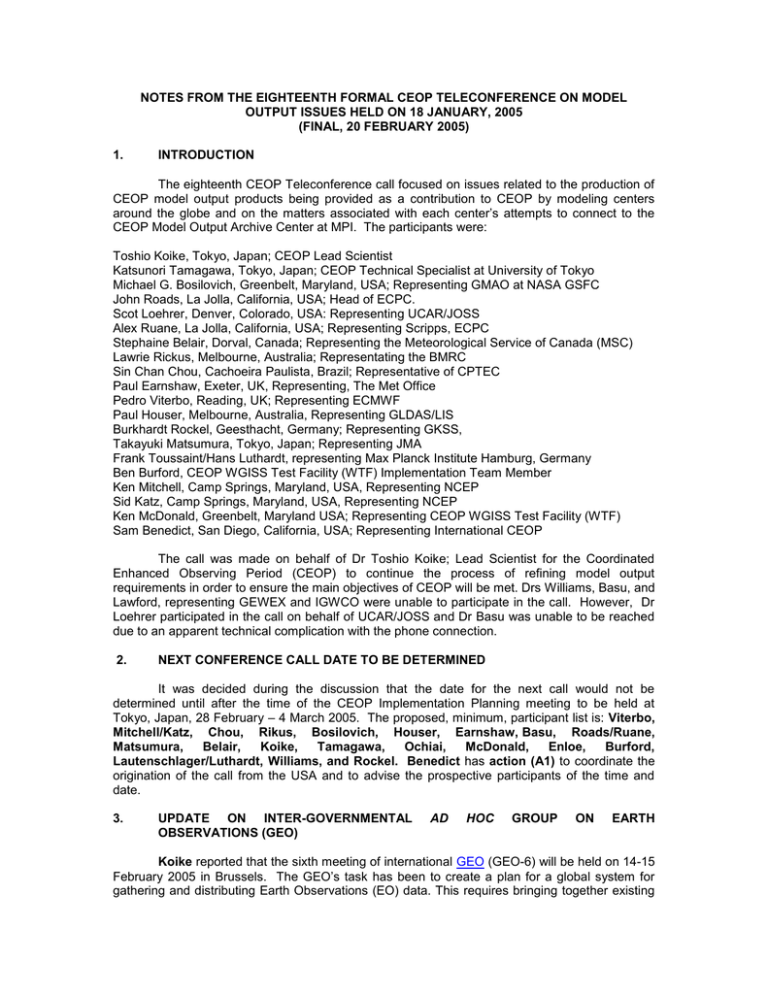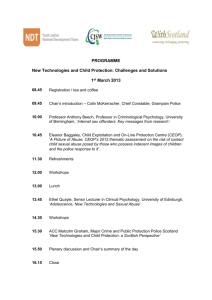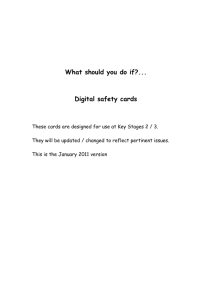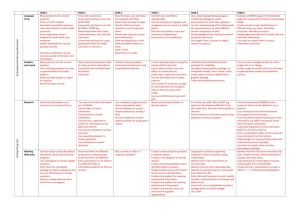NOTES FROM THE EIGHTEENTH FORMAL CEOP TELECONFERENCE ON MODEL
advertisement

NOTES FROM THE EIGHTEENTH FORMAL CEOP TELECONFERENCE ON MODEL OUTPUT ISSUES HELD ON 18 JANUARY, 2005 (FINAL, 20 FEBRUARY 2005) 1. INTRODUCTION The eighteenth CEOP Teleconference call focused on issues related to the production of CEOP model output products being provided as a contribution to CEOP by modeling centers around the globe and on the matters associated with each center’s attempts to connect to the CEOP Model Output Archive Center at MPI. The participants were: Toshio Koike, Tokyo, Japan; CEOP Lead Scientist Katsunori Tamagawa, Tokyo, Japan; CEOP Technical Specialist at University of Tokyo Michael G. Bosilovich, Greenbelt, Maryland, USA; Representing GMAO at NASA GSFC John Roads, La Jolla, California, USA; Head of ECPC. Scot Loehrer, Denver, Colorado, USA: Representing UCAR/JOSS Alex Ruane, La Jolla, California, USA; Representing Scripps, ECPC Stephaine Belair, Dorval, Canada; Representing the Meteorological Service of Canada (MSC) Lawrie Rickus, Melbourne, Australia; Representating the BMRC Sin Chan Chou, Cachoeira Paulista, Brazil; Representative of CPTEC Paul Earnshaw, Exeter, UK, Representing, The Met Office Pedro Viterbo, Reading, UK; Representing ECMWF Paul Houser, Melbourne, Australia, Representing GLDAS/LIS Burkhardt Rockel, Geesthacht, Germany; Representing GKSS, Takayuki Matsumura, Tokyo, Japan; Representing JMA Frank Toussaint/Hans Luthardt, representing Max Planck Institute Hamburg, Germany Ben Burford, CEOP WGISS Test Facility (WTF) Implementation Team Member Ken Mitchell, Camp Springs, Maryland, USA, Representing NCEP Sid Katz, Camp Springs, Maryland, USA, Representing NCEP Ken McDonald, Greenbelt, Maryland USA; Representing CEOP WGISS Test Facility (WTF) Sam Benedict, San Diego, California, USA; Representing International CEOP The call was made on behalf of Dr Toshio Koike; Lead Scientist for the Coordinated Enhanced Observing Period (CEOP) to continue the process of refining model output requirements in order to ensure the main objectives of CEOP will be met. Drs Williams, Basu, and Lawford, representing GEWEX and IGWCO were unable to participate in the call. However, Dr Loehrer participated in the call on behalf of UCAR/JOSS and Dr Basu was unable to be reached due to an apparent technical complication with the phone connection. 2. NEXT CONFERENCE CALL DATE TO BE DETERMINED It was decided during the discussion that the date for the next call would not be determined until after the time of the CEOP Implementation Planning meeting to be held at Tokyo, Japan, 28 February – 4 March 2005. The proposed, minimum, participant list is: Viterbo, Mitchell/Katz, Chou, Rikus, Bosilovich, Houser, Earnshaw, Basu, Roads/Ruane, Matsumura, Belair, Koike, Tamagawa, Ochiai, McDonald, Enloe, Burford, Lautenschlager/Luthardt, Williams, and Rockel. Benedict has action (A1) to coordinate the origination of the call from the USA and to advise the prospective participants of the time and date. 3. UPDATE ON INTER-GOVERNMENTAL OBSERVATIONS (GEO) AD HOC GROUP ON EARTH Koike reported that the sixth meeting of international GEO (GEO-6) will be held on 14-15 February 2005 in Brussels. The GEO’s task has been to create a plan for a global system for gathering and distributing Earth Observations (EO) data. This requires bringing together existing and to-be-developed EO hardware and software and all of the numerous disconnected EO systems and datasets. This means creating a comprehensive ‘system of systems’, delivering solid information on which truly beneficial and sustainable policies can be built. In working towards a system that produces better information on the environment, the GEO hopes to strengthen the ability of decision-makers to tackle pressing societal issues, such as climate change, pollution, humanitarian crises and natural disasters. Following the GEO-6, On 16 February 2005, representatives of more than 50 world governments will meet in Brussels at the Third Earth Observation (EO) Summit, to discuss and promote the development of a comprehensive Global Earth Observation System of Systems (GEOSS). EO wishes to enable the production of better information on the environment, which has become a top priority around the world. Building a GEOSS means bringing together numerous EO sources and datasets and creating a sustainable network for the distribution of data and information products and services. The Brussels EO Summit is the third in a series, following the Tokyo Summit of April 2004 and the Washington EO Summit in July 2003. The overall goal of the EO Summits is to improve coordination of EO strategies and research at a global level. At the Third EO Summit in Brussels, ministers from around the world are expected to endorse a much-anticipated 10-year Implementation Plan for the creation of GEOSS. The benefits of GEOSS will include: 1. Improved understanding of Earth systems, increasing our ability to model atmosphere, land, and ocean processes on regional and global scales; 2. Reduced losses due to disaster, integrating in-situ and space-based observations to forecast hurricanes, droughts, earthquakes and other natural and human-induced calamities; 3. Sustainable development through better understanding of ecological processes and more efficient use of resources. 4.0 PRIORITY TOPICS IN CEOP MODEL OUTPUT DEVELOPMENT All contributing centers have demonstrated that they are able to transfer data to and from the CEOP Model Data Archive Center at M&D/MPI, in Hamburg, Germany. Each Center Spokesperson (Viterbo, Mitchell/Katz, Chou, Rikus, Bosilovich, Houser, Earnshaw, Basu, Roads/Ruane, Belair and Matsumura) agreed to continue to exercise the appropriate links for transfering and accessing the CEOP model data products either via FTP or through the CEOP Model Output Database portal at http://www.mad.zmaw.de/CEOP. 4.1 Priority Actions/Recommendations for a CEOP Model Characteristics Table Because the CEOP Model Characteristics Table at: http://www.joss.ucar.edu/ghp/ceopdm/model/model.html (scroll down) provides a unique and valuable summary/overview for each model in a concise format, which can now be used to move forward efficiently with model intercomparisons, model improvements and model forecasts.CEOP that the, each Center Spokesperson (Viterbo, Mitchell/Katz, Chou, Rikus, Bosilovich, Houser, Earnshaw, Basu, Roads/Ruane, Belair and Matsumura), has the on-going, action A2, to periodically review the table and to keep the entries there current. 4.2 MOLTS Vertical Profile Data Format Rickus has developed a tool, which is being tested by Ruane, Bosilovich and Katz that converts ASCII MOLTS into netcdf Viterbo has agreed to join in the testing of this tool so he can evaluate it in the context of his own earlier efforts to provide such a tool for CEOP. Matsumura and Burford also agreed to continue their interface with Rickus to ensure that the MOLTS data they are providing can be applied in a consistent manner with the tool that is under test. Burford also reported that a few issues that were discovered in the broader system are in the process of being resolved. One item related to variable name rules and how the GRAD-DODS servers treat metadata differently from how various agencies handle it, is requiring communication with the Centers providing data to CEOP for resolution. This issue and others are expected to be resolved by the time of the CEOP 4 th Implementation Planning Meeting that will take place at Tokyo, Japan from 28 February to 3 March 2005. 4.3 Provision of Model Data on Pressure Levels Versus Model Levels Rockel reported on the Inter-CSE Transferability Study (ICTS), which makes use of the CEOP data archive. The ICTS regional atmospheric climate models (RCM) from different Continental Scale Experiments (CSEs) are being transferred from their “home” CSE to other CSEs involved in GEWEX. The models are being initialized and forced at their boundaries by several state of the art Global Circulation Models (GCMs). For evaluation CEOP data from the CEOP reference site data archive and the CEOP satellite data archive are being considered. The main emphasis is on the energy and water cycle components. The global analyses data and associated data centres are listed at: http://www.joss.ucar.edu/ghp/ceopdm/model/model.html. The study is supported in CEOP because it provides an example for application of CEOP datasets, in particularly it fulfills a requirement in WESP of transferring regional models to other regions and contributing to water and energy budget studies. The current work on this task is being undertaken with data from the CEOP Model Output Database in the form of pressure levels versus model levels and the results are available to the group with an evaluation of its applicability in assessing LAMs. It is a continuing request for all the CEOP Model Data Providers who are producing data in pressure levels versus model levels or who can produce such data to send it in that form to MPI for this application and other related research. 4.4 CEOP Reference Site Data Required for Model Validation The CEOP table at: http://www.joss.ucar.edu/ghp/ceopdm/model/model.html, which summarizes some basic characteristics of models providing MOLTS output for CEOP, was discussed in the context of descriptions of the soil and vegetation cover at the CEOP reference sites that are needed for more detailed comparisons between in-situ and model data. Viterbo subsequently drafted a list from the discussion (see attachment). Benedict accepted action A3 to request that the CEOP reference site spokespersons consider the Information provided at the time of the next CEOP International Conference Call on 25 January 2005. 4.5 CEOP WGISS Test Facility Network Support Burford and McDonald reported that testing of the preliminary design of the CEOP WTF server is advancing. In particular, the network testing of the OPeNDAP (DODS) environment is being further developed. Burford has subsequently been moving ahead with discussions related to putting MOLTS data online, on the WTF-CEOP system. Several responses from the participants on the call about what time series of MOLTS data will be useful to the CEOP research community have allowed progress to be made on this matter. The connection to MPI has also been under further discussion and Burford, Lautenschlager and Toussaint accepted an action A4 to carry through with the detailed technical discussions related to resolving this interface during the time of the CEOP Implementation Planning Meeting at Tokyo 28 February to 4 March 2005. I've had some prelimin ary discussions with John and Lawrie and I would like to open up this discus sion. 4.6 Status of Contributions to Model Output Component of CEOP/Sample Data Transfer Reports provided during the call made it clear that the work of producing and transferring the required model output to CEOP has been progressing well and some data from every Center except GLDAS and Environment Canada having been received, verified and placed on the CEOP Model Output Database at the Model and Data Group facility at Hamburg, Germany. Nearly completing this action for all the participants. The Table below is the latest version of the available data at the Hamburg Data Center. All the Center Spokesperson (Viterbo, Mitchell/Katz, Chou, Rikus, Bosilovich, Houser, Earnshaw, Basu, Roads/Ruane, Belair and Matsumura), have an on-going action A5, to review the table and verify the level of success of their contribution up to the current time. A link to the Table can be found at the following Internet URL: http://www.mad.zmaw.de/CEOP/Data_timeline.html. There is a tabular version of the Table as well, which can be found at the following location: http://madweb.dkrz.de/CEOP/ceop_overview.html. Links exist from there that will lead to the actual data. Data sets included into CERA (as of 11-FEB-2005 ) Centre MOLTS data GRID data NCEP 01-DEC-2002 – 31-DEC-2004 CDAS : 01-OCT-2002 – 31-DEC-2004 (1) CDAS: - 01-OCT-2002 – 31-DEC2002 UKMO 01-OCT-2002 – 29-FEB-2004 01-OCT-2002 – 30-FEB-2004 NASA-GMAO 01-JUL-2001 - 31-OCT-2002 01-JUL-2001 - 30-SEP-2001 NASA-GLDAS - - JMA 01-OCT-2002 - 30-DEC-2004 01-OCT-2002 - 30-DEC-2004 BMRC 01-OCT-2002 - 30-SEP-2003 - ECMWF - 01-JUL-2001 - 31-AUG-2002 NCMRWF - 01-OCT_2003 - 30-APR-2004 ECPC SFM : RII : 01-JUL-2001 – 31-MAR2002 (*) SFM : RII : 01-JUL-2001 – 31-MAR-2002 (*) CPTEC/INPE - 01-JUL-2001 – 30-SEP-2001 CMC (1) Analysis data are split up into time series for individual variables and levels(*) : only RII36 data included You may also find a timeline presentation of the available data periods. There is a Change log available now! Total amount of CEOP data within CERA: appr. : 1.261 Tbyte. Strawman for MOLTS sites vegetation and soil description (modeller’s perspective) Version 0, 18th January 2005 1 Preamble Ideally, the following information is needed separately for each of the several instrument locations that might exist in one MOLTS site. 2 Descriptive information The following bullets list several characteristics that models need to help understanding/interpreting observation results and setup model parameters. Each location will find its own way of providing the information; It will be very difficult to find a frame that serves all sites. The description will have a geographer/ecologist/geologist focus. Vegetation 3 o Description of site. Horizontal length scales (such as fetch, size of patches of vegetation, vegetation height) o Types/ages of natural vegetation present, patchiness; cultivars, if existing o Phenology: Basic seasonal events (leaf-up, leaf drop-off, …) climatology Soils o Descriptive nature of soils (e.g. ISRIC world soil database) o Soil horizons o Organic soil information, if appropriate o Bedrock, if known o Presence of continuous/discontinuous permafrost; If discontinuous, provide the depth of frozen soil General o Terrain (orographic details at and near the site) o Vicinity of water (lakes, river, …) o Water table depth (if it is believed to be close to surface) o Existence of subterranean aquifers o Proximity of irrigation and details of irrigation (if appropriate) o General geologic information, if available Quantitative information The following lists quantitative information that modellers would need . Vegetation form and function parameters o Vegetation type (according to some classification); Information list in Section 2 might be enough o Leaf area index (time series information) o Phenology: Basic seasonal events (leaf-up, leaf drop-off, …) time series o Height of vegetation o Vegetation cover [i.e., (1-bare_ground_fraction), for each biome] Soils o Soil type (Clapp/Hornberger), if available o Texture (% clay, % sand) o Density o Permanent wilting point o Porosity General o Latitude, longitude o Terrain height of location (and some characteristic of surroundings)







